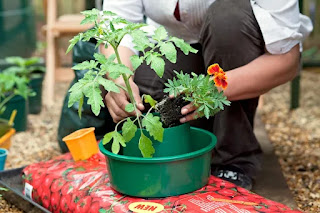We list 10 companion planting combinations to grow, in the garden and the
vegetable plot.
What is companion planting?
Companion planting is an organic method of maintaining
a natural balance in your garden by
growing plants together that are mutually beneficial. Planted together, certain
plant combinations can aid pollination, prevent disease and keep pest numbers
down. Most companion plants are strongly scented and can confuse pests looking
for their host plant, some have antibacterial or anti-fungal properties, while
others attract beneficial insects, such as ladybirds and lacewings, which prey
on aphids. Most companion planting occurs in the vegetable patch, but some
ornamental plants, such as roses, can also benefit from particular plants
growing nearby.
Common plant combinations include
growing nasturtium to deter aphids from beans, and planting alliums around
carrots to ward off carrot root fly.
What are the benefits of companion planting?
Companion planting can help your
plants to grow better and with fewer pests and diseases. Ultimately this
benefits the gardener as this means less work for higher crop yields.
Plant combinations to avoid
There are some obvious plant
combinations to avoid, for example you should avoid planting tall plants next
to shorter plants, as they will block light and prevent them from growing well.
Growing thirsty plants next to drought-tolerant plants is also not advised, as
one plant will either be getting too much water, or too little.
Some plants appear to have what's
known as allelopathic properties. This means that the plants release chemicals
that inhibit growth of other plants. One of the most commonly known plants
thought to be allelopathic is the walnut tree – it's commonly advised not to
grow plants close to walnuts as they won't thrive. However, this theory has
been disputed in horticultural circles and it's not known for certain how
allelopathic walnut trees really are.
There's no science to confirm or
deny allelopathic properties in plants, and much more research needs to be done
but, anecdotally, the following plants are thought to not grow well together:
- Garlic
and onions with beans and peas
- Mint
or onions with asparagus
- Cucumbers,
squashes, radishes, sunflowers or tomatoes with potatoes
- Cabbages
or other brassicas with strawberries
- Brassicas
and potatoes with tomatoes
Browse our list of the best
companion plant combinations, below.
Mint and brassicas
Marigolds and tomatoes
The strong scent of French marigolds (Tagetes) is said to deter whitefly, which is particularly useful when planted alongside tomatoes in the greenhouse.
Carrots and leeks
Strongly scented crops can work wonders on the vegetable patch. Alliums such as onions, garlic and leeks are often paired with root crops like carrots and parsnips. This combination seems particularly effective – the smell of carrots can deter leek moth from leeks, but the small of leeks can deter carrot fly from carrots. If you don't have room for leeks, try garlic chives (Allium tuberosum) as an alternative.
Lavender with carrots and leeks
Lavender attracts a range of pollinators, including
bees, butterflies and hoverflies, so planting it close to crops such as
tomatoes and beans could increase numbers of pollinators to your patch.
However, its strong scent can also deter insect pests – plant with carrots and
leeks for the best results.
Wormwood and beans
Wormwood, Artemisia absinthium, is a
strongly scented herb that can deter aphids such as blackfly, from broad beans
and other bean crops. What's more, its yellow flowers attract hoverflies,
lacewings and ladybirds, which prey on aphids.
Calendula and beans
The marigold, Calendula officinalis, can lure
aphids away from beans, and makes a great companion plant for runner beans and
French beans. It also attracts beneficial insects, including ladybirds,
lacewings and hoverflies, which prey on aphids.
Sage and brassicas
Sage, Salvia officinalis, is strongly scented and will confuse pests of brassicas, such as flea beetle, if planted alongside them. What's more, its blue flowers attract bees and hoverflies, which also pollinate crops.
Borage and strawberries
Borage is an
attractive plant with hairy leaves that have a slight cucumber flavour. If
planted near strawberries, borage is said to improve their flavour. What's
more, borage flowers are a magnet for pollinators, such as bees, butterflies
and hoverflies, which pollinate crops.
Thyme and roses
Another strongly scented herb, thyme is an excellent companion plant as it can confuse pests by masking the scent of the pest's host plant. Thyme makes a good companion plant for roses, as its strong scent deters blackfly.
Calendula and courgettes
Calendula is extremely attractive to pollinators, and can therefore increase pollination of some vegetable crops. Underplanting courgettes with calendula can be extremely useful, especially in dull weather, when courgette flowers may be overlooked by pollinators.







No comments:
Post a Comment